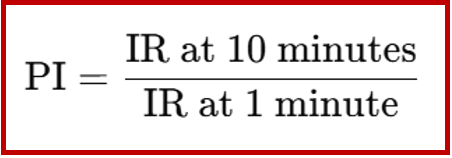Testing the insulation quality of transformers and motors is critical for ensuring reliability, efficiency, and safety. One of the most reliable methods for this is the PI and DAR test.
These tests — short for Polarization Index (PI) and Dielectric Absorption Ratio (DAR) — help evaluate the condition of electrical insulation, detect moisture ingress, and identify potential faults before they lead to failures.
In this guide, you’ll learn what the PI and DAR test involves, how to calculate each value, acceptable ranges, and why they are essential for equipment maintenance.
What is the Polarization Index (PI)?
The Polarization Index is a measure of the condition of insulation in electrical equipment such as transformers and motors. It helps detect issues like moisture ingress, dirt contamination, and insulation deterioration.
Definition: The PI is the ratio of the insulation resistance measured after 10 minutes to the insulation resistance measured after 1 minute, using a megohmmeter (insulation resistance tester).
Polarization Index Formula

Where:
- IR = Insulation Resistance (in MΩ)
- Time is measured from the moment the DC voltage is applied.
Polarization Index Table (Interpretation Guide)
| PI Value | Insulation Condition | Action Required |
| > 4.0 | Excellent | No action needed |
| 2.0 – 4.0 | Good | Equipment in good health |
| 1.0 – 2.0 | Questionable | Plan maintenance soon |
| < 1.0 | Poor | Immediate action required |
Acceptable PI Values
- For Transformers:
- New equipment: PI ≥ 2.0 is generally acceptable.
- In-service: PI should be above 1.5.
- For Motors:
- PI should generally be ≥ 2.0 for healthy insulation.
- Lower values indicate contamination or moisture problems.
- For Cables:
- PI should be ≥ 2.0 for new cables.
- Values between 1.5 and 2.0 suggest aging or minor degradation.
- PI < 1.5 indicates possible moisture ingress or insulation damage.
What is the Dielectric Absorption Ratio (DAR)?
The DAR test is a quicker insulation assessment method compared to PI. It measures the ratio of insulation resistance at 60 seconds to that at 30 seconds.
DAR Formula

Where:
- IR = Insulation Resistance (in MΩ)
- Time is measured from the moment the DC voltage is applied.
DAR Test Interpretation
| DAR Value | Insulation Condition |
| > 1.6 | Excellent |
| 1.4 – 1.6 | Good |
| 1.0 – 1.4 | Fair |
| < 1.0 | Poor |
PI vs DAR – When to Use Each
- DAR is suitable for quick checks and modern insulation materials that saturate quickly.
- PI is better for older equipment with paper or composite insulation where absorption effects are more pronounced.
PI & DAR Test Value in Motors and Transformers – Why It Matters
- A low PI can mean contaminated insulation or moisture absorption.
- Regular PI and DAR testing helps avoid catastrophic insulation failures and extends equipment lifespan.
Steps to Perform a PI and DAR Test
Performing a Polarization Index (PI) or Dielectric Absorption Ratio (DAR) test requires careful preparation and adherence to safety guidelines. Follow these steps:
- Isolate and De-energize the Equipment
- Ensure the equipment or circuit under test is completely disconnected from all power sources.
- Lockout/Tagout (LOTO) procedures should be followed to prevent accidental energization during testing.
- Verify absence of voltage using an appropriate voltage detector before proceeding.
- Discharge the Equipment
- If the equipment was recently energized, residual charges may still be present.
- Safely discharge any stored energy in capacitors or windings by grounding them for a few seconds.
- Connect the Megohmmeter (Insulation Resistance Tester)
- Connect one lead of the megohmmeter to the conductor or winding under test.
- Connect the other lead to the equipment’s grounded surface (earth).
- Ensure firm and secure connections to avoid false readings caused by loose contacts.
- Select the Appropriate Test Voltage
- Choose the test voltage based on the equipment rating:
- 500 V DC – for low-voltage equipment.
- 1000 V DC – for medium-voltage equipment.
- 2500–5000 V DC – for high-voltage equipment, such as large transformers and motors.
- Always follow the manufacturer’s recommendations for maximum allowable test voltage.
- Choose the test voltage based on the equipment rating:
- Perform the Test and Record Readings
- For DAR:
- Record the insulation resistance at 30 seconds and at 60 seconds after applying the test voltage.
- For PI:
- Record the insulation resistance at 1 minute and at 10 minutes after applying the test voltage.
- Avoid touching the equipment or test leads during the measurement to prevent electrical hazards and interference.
- For DAR:
- Calculate PI or DAR
- Use the following formulas:
- DAR = IR60s/IR30s
- PI = IR10min/IR1min
- Compare the results to industry standards or manufacturer guidelines to assess insulation health.
- Use the following formulas:
- Discharge the Equipment After Testing
- Once the test is complete, use the megohmmeter’s built-in discharge function (if available) or manually ground the tested conductor to safely release stored energy.
Advantages of PI and DAR Test
The insulation resistance of any insulating material decreases as its temperature increases. Because of this, a single insulation resistance (IR) reading may not accurately reflect the true condition of the insulation — it is heavily influenced by temperature at the time of measurement.
The Polarization Index (PI) and Dielectric Absorption Ratio (DAR) tests overcome this limitation by using a ratio method. In both tests, readings are taken at two different time intervals, but under the same temperature conditions.
This makes the measurement largely independent of temperature, ensuring more reliable and accurate results for insulation assessment.
Conclusion
The Polarization Index and Dielectric Absorption Ratio tests are essential tools for assessing insulation health in transformers and motors.
- PI gives a deeper insight into insulation condition over time.
- DAR offers a quicker assessment.
Maintaining acceptable PI and DAR values ensures better reliability, reduced downtime, and longer equipment life.
Related Articles: